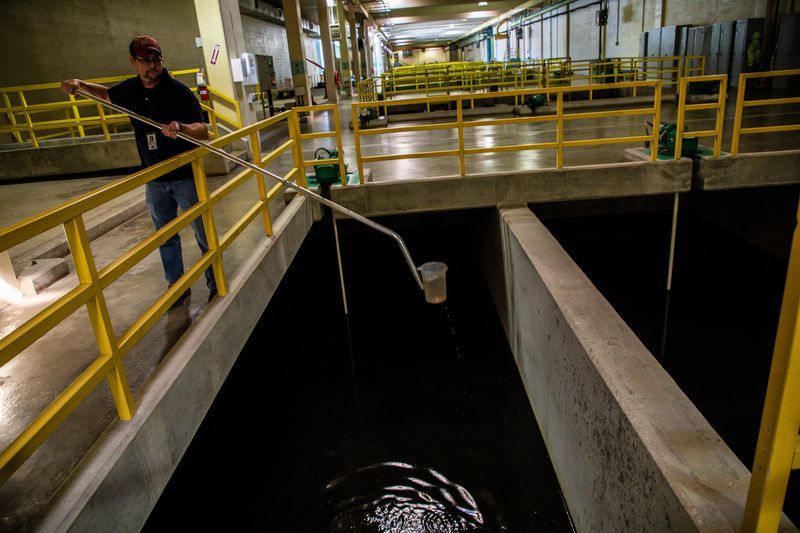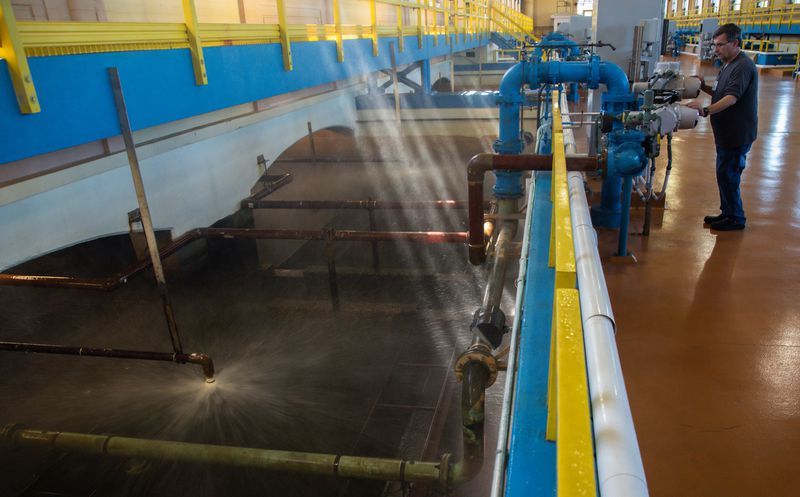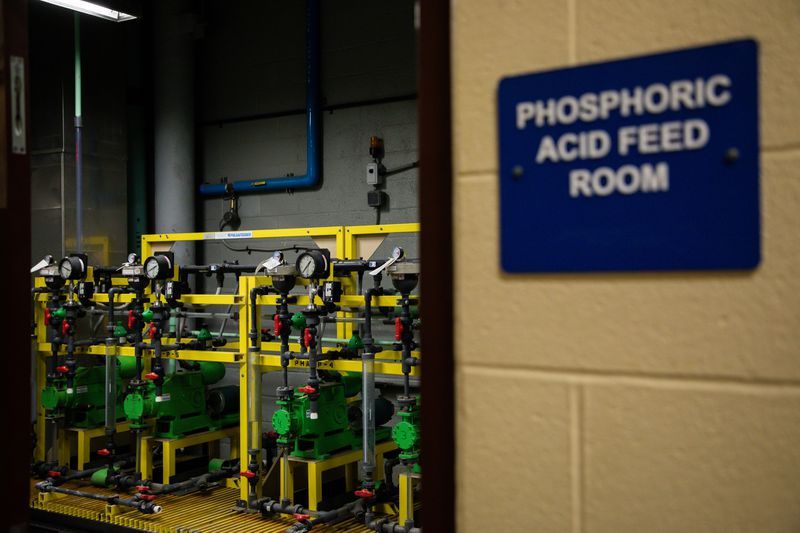Since moving to the Cleveland area seven years ago, Malina Cano Rauschenfels has become accustomed to discolored water flowing from her faucet, although she has never fully understood the reason behind the yellow or brownish tinge.
Cano Rauschenfels, 41, who tutors schoolchildren in music from her Cleveland Heights home, occasionally sees the city of Cleveland’s Division of Water notifications advising residents to avoid washing laundry because the sullied tap water may stain clothes — but that the water is still safe to drink. After cleaning brown sludge from her water filtration system, Cano Rauschenfels remains skeptical.
“I would be terrified to give my kids this water,” she said. “Don’t wash your clothes or do laundry, but drinking it is fine? What are the effects of that?"
For the past two decades, these outbreaks of tainted tap water have occurred periodically in late summer. They have stained plumbing fixtures, ruined loads of laundry, and produced odd smells and a metallic taste.
By all accounts, it has been a nuisance to many customers of Cleveland’s water department, the nation’s 10th largest water system that serves 1.4 million people. But it may be representative of a more serious issue tied to Lake Erie’s “dead zone,” a sprawling layer of deep water with so little oxygen that many fish can’t survive.
As agricultural runoff and urban wastewater pour into Lake Erie, the nutrients and warmth of the shallowest Great Lake give rise to massive blooms of algae and bacteria. This plethora of microbes in Erie alone outnumbers the stars in the universe, according to scientists.
Each summer, when legions of algae and bacteria die, they precipitously fall to the lake bottom, and their microscopic corpses rot en masse. In the deeper waters of Lake Erie’s central basin, the process of decomposition depletes the oxygen in the bottom waters.
When this oxygen-deficient water interacts with Erie’s lakebed sediments and clay, heavy metals such as manganese and iron are released from the muck into the water. In particular, manganese not only causes discoloration but also has been linked to permanent neurological issues. Low-oxygen conditions also contribute to more caustic water that can slowly corrode lead and copper service lines over time and raise the potential for exposure to those metals.
Meanwhile, in the lake, once oxygen levels drop below a certain threshold, coldwater fish and bottom-dwelling aquatic organisms suffocate or are forced to migrate, turning much of the central basin’s bottom waters into a dead zone.
Between the 1960s and the 2000s, the number of dead zones worldwide has doubled every decade as a result of human activities and a warming atmosphere.
Globally, scientists have identified more than 400 dead zones in ocean waters including the Gulf of Mexico, Long Island Sound and Chesapeake Bay. But freshwater dead zones, which scientists are learning may pose a risk to drinking water, exist throughout the Great Lakes, including Lake Michigan’s Green Bay, Lake Huron’s Saginaw Bay, Lake Ontario’s Hamilton Harbour and Lake Erie’s central basin.
Federal studies on climate change show the Midwest is experiencing heavier rainfall. This precipitation has swept more waste into coastal areas, a trend that has promoted larger algae blooms and oxygen deprivation. With a warming climate, dead zones are persisting longer, prolonging stifling ecological conditions and raising the probability for fouled water to wash into coastal drinking water intakes.
Just over a decade ago, levels of heavy metals in raw Lake Erie water climbed to problematic levels. Scientists and water treatment officials only then learned about the dead zone’s potential effect on coastal drinking water and are still trying to understand how serious of a health risk it could be.
“It’s mostly a nuisance, but it can be a health concern,” said Ed Verhamme, a coastal engineer at LimnoTech, an environmental consulting firm that helps Cleveland track the dead zone.
Alex Margevicius, commissioner of the Cleveland’s Division of Water, said treating water is now more complex.
“Here, in Cleveland, and in a lot of places in the Great Lakes, we worried about treatment and distribution: treating the water and sending it where it needed to go,” he said. "Source, we didn’t think about it for decades and decades. In the last 15, 20 years that has dramatically changed. We have focused on what goes on in the lake. What surprised me, as much as anything, is how complex Lake Erie is as an ecosystem; the biology, chemistry, the physics of what goes on is incredibly complicated.”
The tell-tale sign
Lake Erie’s dead zone, which can span an area the size of Connecticut, lies mostly in deep, offshore waters. However, northeastern winds can push this water toward Ohio’s shoreline, where it threatens a number of major municipal water intakes from Lorain, 30 miles west of Cleveland, to Ashtabula, 60 miles to the east.
When this happens, water treatment officials must act quickly to adjust the amount of certain chemicals in the treatment process.
In late August, Cano Rauschenfels went to fill a jug for her water filtration system with water from her tap and noticed it was “completely brown.” The incident only justified her purchase of the pricey system capable of purifying municipal water and even filtering raw water from lakes and stagnant ponds.
When a friend called the Cleveland water department to inquire about the discoloration, Cano Rauschenfels learned the cause was elevated levels of manganese. Still, she and many neighbors didn’t know what to make of that information.
“My sense is, most people are clueless,” Cano Raushenfels said. “My kids ask, ‘Why do you get water from (a filtration system)?’ Based on their reaction, my guess is they are not using a filter at home — that no one thinks about it. They just assume it’s safe.”
The first known and most severe episode occurred in 2006. It was then that water treatment officials began to understand what they were dealing with.
The tell-tale sign was an incursion of cold water.
On Aug. 9, 2006, the temperature near the Crown Water Treatment Plant dropped from 77 degrees to 64, a sign that deep offshore water had engulfed the intake crib. A prevailing northeasterly wind blew across the lake, guiding low-oxygen water into three of the four water treatment plants. For more than a week, discolored water loaded with heavy metals was pumped throughout much of the distribution system.
Manganese, a prevalent element found in the lakebed, was one of the metals drawn into the water supply. In low amounts, manganese is an essential mineral that helps the human body with metabolism and bone formation. If consumed in excess, manganese can be a potent neurotoxin that causes long-term impairments that resemble Parkinson’s disease.
The Environmental Protection Agency currently recommends that infants and pregnant and nursing women should not drink water with manganese concentrations above 0.3 milligrams per liter over a 10-day period. For healthy adults, levels should not be more than 1 milligram per liter. The agency also encourages water treatment facilities to keep levels below 0.05 milligrams per liter, the threshold at which discoloration can occur, but it does not require treatment plants to test the water for manganese or comply with the standard.
During the 2006 incident, which lasted up to 12 days, manganese concentrations at the Crown plant spiked above 1 milligram per liter at times.
Complicating matters, Cleveland was treating the water with potassium permanganate, a chemical that — at the right dose — can remove heavy metals like manganese. But if the correct amount isn’t added, it can exacerbate manganese levels.
“If you have a groundwater system that gets manganese at a constant level all the time, you know how to treat for that,” said Margevicius, the water commissioner. “When you get an event where there’s an erratic bouncing up and down, you have to have the treatment match the level coming in. If you miss that, the amount of chemical addition to that can make it worse."
To remedy the problem, water treatment officials decided to increase the feed of chlorine, a disinfectant that can reduce manganese levels but at the expense of increasing other chemical byproducts.
Plant officials also had another problem. The raw water’s pH, a measure of acidity or lack thereof, had plummeted, nearing a level in which it would be acidic. When treating lake water, some chemicals can further lower the pH. If the water becomes acidic, that could pose a problem to the lead and copper service lines that connect homes and businesses to water mains.
Cleveland Water adds an anti-corrosive substance to the water that coats residential piping, acting as a buffer.
“If the pH goes bad too long, that protective coating can start to break down, and you can start to get lead in the drinking water,” Margevicius said.
During the 2006 incident, Cleveland officials didn’t understand what was happening at their plants. Now, a network of buoy sensors acts as sentinels monitoring wind speed and direction, water temperature and oxygen levels.
For more than three years, scientists at the National Oceanic and Atmospheric Administration have been reviewing this buoy data alongside water quality measurements from Cleveland water treatment plants to build an experimental dead zone forecast system. Unveiled to the public this year, the modeling system is intended to provide an advanced warning of incoming low-oxygen water, allowing Cleveland Water officials to adjust their treatment approach.
But even when computer models can anticipate low-oxygen water, problems still crop up.
A delicate dance
Three months ago, plant officials were alerted by the new system. On the morning of Aug. 26, they noticed the manganese levels in the raw water were rising and pH was taking a downturn. But officials had a strategy.
The plant stepped up its infusion of sodium hydroxide, a corrosion control agent that raises the water’s pH.
Then they halted their feed of potassium permanganate, an action they typically take when manganese levels hit the water discoloration level.
Cleveland Water employees fanned out across the northeast side because it is serviced by a facility with the deepest intake crib and the one that is typically hit the hardest by dead zone water. They opened hydrants to flush out the water before too much could reach their customers.
But as many as 21 of Cleveland Water’s 80 communities still received advisories about discolored water and warnings not to wash laundry.
Testing at the last hydrant in an east Cleveland neighborhood revealed as much as 1.3 milligrams of manganese per liter, a reading officials said appeared to be “anomalous” because of contaminants built up at the end of a water main. Another measurement taken at another site was just shy of 0.3 milligrams.
This was one of eight instances this year when NOAA’s experimental system warned lakefront communities of hazardous water conditions.
Officials say the late August alert was a mild occurrence, albeit one that kept them on their toes.
“In the early period of this event, it’s almost like the fog of war,” said Margevicius, referring to the delicate dance of implementing the proper measurements in real time.
Bigger than expected
Once the dead zone forms, the proliferation of manganese in the bottom waters lasts for months until fall weather arrives. When Lake Erie’s surface waters chill, becoming colder and more dense than bottom waters, the entire lake mixes, rejuvenating oxygen levels in the deep water and dissipating the dead zone.
This mixing can release a large bubble of noxious gas from the dead zone. On Sept. 29, 2005, residents from Cleveland to Buffalo, New York, reported a pungent odor described as “rotten eggs” or “sewer gas.” The mystery scent stirred up a “mild panic,” according to the U.S. Environmental Protection Agency, as rumors spread about a natural gas leak or a possible chemical plant explosion, and emergency responders rushed to investigate in Pennsylvania.
It turns out the “big burp” of 2005 was a buildup of hydrogen sulfide gas produced by bacteria decomposing the heap of dead algae at the bottom of Lake Erie.
With climate change, warmer weather has appeared earlier in the spring and persisted later into the fall, meaning the dead zone and its accumulation of manganese and dead algae can be prolonged.
With sediment samples from Lake Erie’s lakebed, scientists are simulating low-oxygen conditions in an attempt to gauge how fast manganese leaches from the soil into the water.
While the research is still pending review, Craig Stow, a NOAA scientist, said the preliminary data indicates that manganese pulled from the lake bottom "seems to come out pretty fast.”
Scientists realize they still have much to learn.
Two years ago, researchers confirmed the existence of a dead zone closer to shore.
A water quality buoy positioned near one of Cleveland’s intake cribs picked up on low-oxygen conditions in June 2017, much earlier in the year than when Lake Erie’s dead zone typically forms. Verhamme, the coastal engineer, went to investigate, finding oxygen-depleted conditions near the mouth of the Cuyahoga River.
Each year since, this dead zone has returned.
“It appears the dead zone had always been that close, but there was never any monitoring there,” Verhamme said. "No one had been looking for it."
The experimental forecast system assumed oxygen depletion started in Lake Erie’s deep, offshore waters and spread outward. Now, it appears rotting algae can more easily expend oxygen levels in warm, shallow waters, forming another dead zone when the waters are still.
This can later merge with the larger, offshore dead zone that forms later in the summer.
Experts say the newly discovered dead zone may not be as much of a manganese threat, due to differences in the lakebed sediment near shore. But low pH is still a problem.
While that knowledge will lead to further investigation into the dead zone and hopefully a more accurate forecasting system, that doesn’t assuage the worries of Cleveland residents like Cano Rauschenfels who have come to expect tainted water every summer.
"Does it take a generation of brain damage to let us know?” she wondered.




